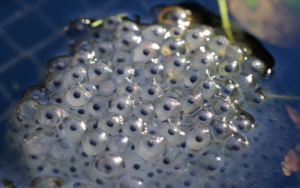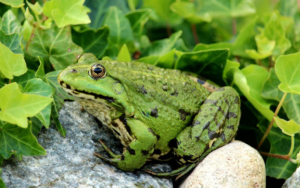Frogs and toads both eat a range of insects, including many larger insect pests, such as flies, moths, and beetles. They are also very useful for controlling slugs and snails, which are good for soil health but can immediately become pests if not controlled. This makes them a natural predator of garden pests that affect your plants, mosquitoes, and other insects that affect you while you garden. In addition, as they are carnivores as adults, they won’t damage your garden plants at all.
Consequently, attracting frogs and toads is an excellent way of naturally controlling pests in your garden. There are a few things that you can do to entice frogs and toads to your garden and make it more likely that they’ll stay.
Attracting frogs to your garden is simple. It only takes knowing their preferred habitat, behaviors, and breeding patterns, and then, making sure that your garden has suitable areas for such behaviors.
The tips given below are only generalizations. You can make your garden specifically suitable for frogs native to your area to attract a larger number of frogs and create a bigger impact.
1. Provide a pond or other water source for frogs to use and lay eggs in.

As you know, frogs are amphibians and don’t go far from water. They like damp environments and need water to reproduce. Most frogs lay their eggs in water, and the tadpoles that hatch out of them have tails like fish and breathe through gills, so they need to live in water at this stage. Afterward, they lose their gills, absorb their tails, and grow legs when they metamorphose and turn into adult frogs.

To make your garden a suitable place for frogs to live and reproduce, creating a pond in your garden is the best solution. Despite this, shallow puddles of water or small pots filled with water that isn’t allowed to dry up can be more than enough.
2. Provide frogs with shelter from extreme weather and predators.
Frogs also need sheltered areas where they can hide from the harsh sun, hibernate when it gets too cold, and be protected from small mammals, birds, snakes, and other predators. You can easily create sheltered areas using stones, densely grown plants, broken flower pots, or small containers.

3. Make your garden frog-friendly by not using any harsh chemicals.
Frogs can absorb moisture from their surroundings thanks to their porous and sensitive skin. Unfortunately, given the porous nature of their skin, they can also inadvertently absorb chemicals from their surroundings. As a result, frogs may suffer from disabilities, which can be fatal or even wipe out entire populations.
This means that you should not use any harsh chemicals, such as pesticides and herbicides, in your garden if you’d like frogs to do their pest control magic!
Additionally, not using harsh chemicals will encourage a range of insects and other small creatures that are food for frogs, so that they don’t leave your garden due to a lack of food.

Frogs are great at natural pest control. You can make your garden attractive for frogs by creating a damp environment, creating sheltered areas, and not using harsh chemicals that could harm frogs and eliminate their food sources.
Find out more about naturally controlling pests in your garden:


